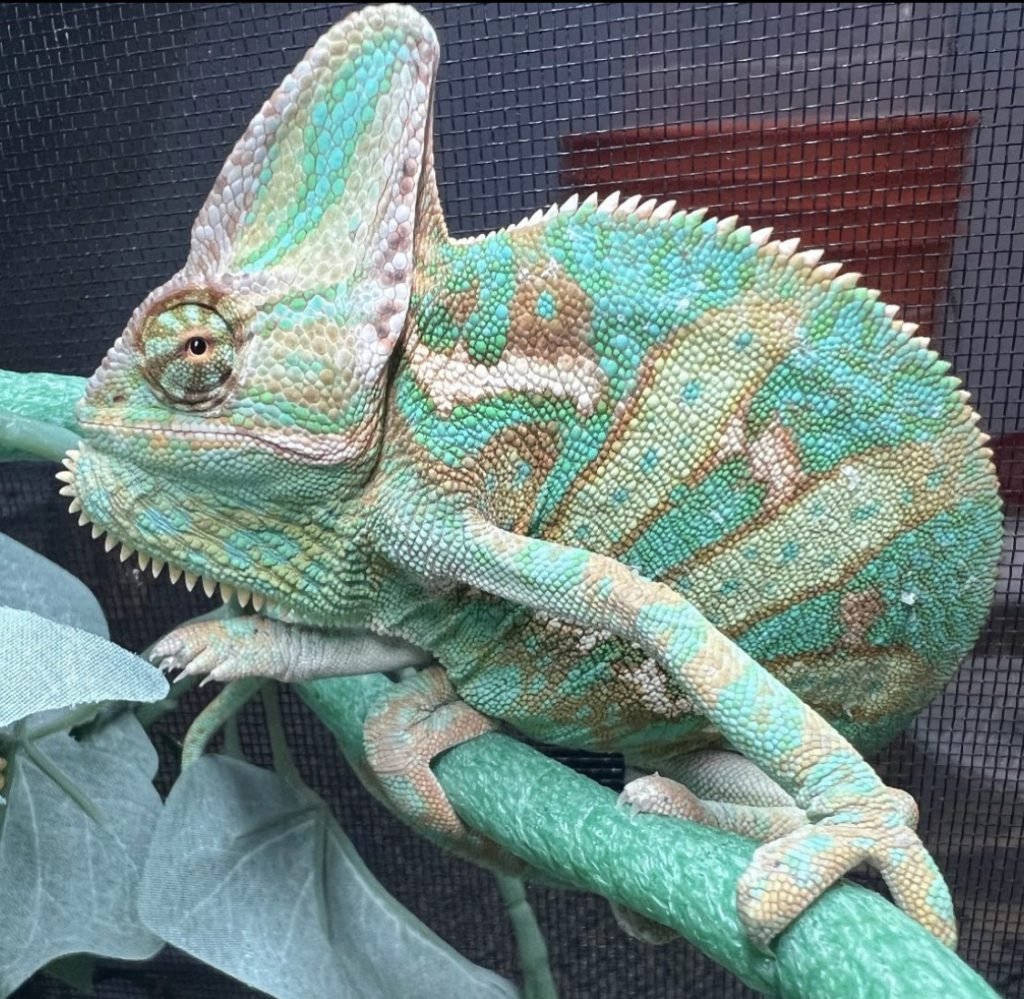Choose the ideal type of chameleon as a pet for you. Explore the different pet chameleons, their habits, and their care demands.
It’s no wonder chameleons are popular exotic pets. These exotic reptiles make fascinating pets. Chameleons’ color-changing, prehensile tails and independently moving eyeballs are fascinating. Despite their popularity, chameleons are only for some, so it’s essential to understand their demands and character traits before getting one. This tutorial will explain why chameleons are such popular pets and their distinctive attributes.
Different Types of Chameleons as Pets

Panther Chameleons
- Physical appearance: Panther chameleons need a large, well-ventilated terrarium with adequate temperature, humidity, and light. As severe insectivores, they need a diversified diet of live insects. To stay healthy and happy, they need climbing space and hiding spots.
- Temperament: Panther chameleons are peaceful pets for experienced reptile keepers. They are vulnerable to stress and might get sick in a hostile environment.
- Care requirements: Panther chameleons need a large, well-ventilated terrarium with adequate temperature, humidity, and light. As severe insectivores, they need a diversified diet of live insects. To stay healthy and happy, they need climbing space and hiding spots.

Veiled Chameleons
- Physical appearance: Veiled chameleons are also a popular pet species. Their characteristic helmet-like casque distinguishes them on their heads and their vast size, which may reach up to 24 cm in length. Yemen and Saudi Arabia are their natural habitats.
- Temperament: If you have experience with reptiles, a veiled chameleon may be a lovely pet for you. Despite their obedience, they’re sensitive creatures that can get freaked out from being rubbed too much.
- Care requirements: Keep your veiled chameleon in a large, well-ventilated terrarium with optimal temperature, humidity, and lighting. Like other insectivores, they need a diet rich in various live bugs. They’ll feel safest if there are many places to climb and hide.

Jackson’s Chameleons
- Physical appearance: All three horns on the heads of Jackson’s Chameleons have a different color, with these reptiles varying in hue from green to yellow to blue. In comparison to other chameleons, their bodies are much smaller.
- Temperament: Jackson’s Chameleons are more energetic and hostile than other chameleons, making them ideal for more experienced reptile lovers.
- Care requirements: Jackson’s Chameleons need a big, well-ventilated enclosure with climbing and perching branches and living plants. They also need a heat source, a misting system, and UV lights to maintain their health and well-being.

Pygmy Chameleons
- Physical appearance: Pygmy chameleons are among the tiniest species, measuring about 4 to 6 cm in length. They are well-known for their distinctive and colorful patterns, and their small size makes them a popular choice for individuals with limited space for a pet reptile.
- Temperament: Pygmy chameleons do not attack people like other reptiles. It is essential to treat them gently and adequately since they are shy creatures that might grow upset if touched too often.
- Care requirements: Pygmy chameleons are relatively easy to care for but require specific environmental conditions to thrive. They need a warm and humid environment, with a temperature range of 70-80°F and a high humidity level. They also need a well-planted enclosure, as they are arboreal creatures that spend most of their time in the trees. It is essential to feed them various live insects and provide them with a water source for drinking and bathing.
Factors to Consider When Choosing a Chameleon as a Pet
When evaluating the purchase of a chameleon as a pet, it is vital to be aware of the elements to consider. As pets, chameleons provide many obstacles while being exciting creatures.
Space Requirements
When buying a chameleon, it is essential to consider the amount of room available for their habitat. Chameleons are herbivore animals that require a big cage with lots of climbing space. Consider the size of your house and the room available for your pet.
Cost
Chameleons may be costly to keep as pets since they have specialized nutritional and habitat demands. When considering if a chameleon is a good pet for you, keep the cost of their habitat, food, and supplies in mind.
Experience Level
Chameleons are not ideal for first-time reptile keepers since they are delicate and highly nervous species. Consider your degree of experience with reptile care and if you are ready for the challenges of having a chameleon.
Availability
Finally, evaluate the availability of chameleons in your region. It’s essential to learn which species are easily accessible, as some are sold more frequently than others at pet stores. Only buy chameleons from authorized breeders or pet retailers, as an underground market can devastate native populations.
FAQ about types of chameleons as Pets
What are the most popular types of chameleons kept as pets?
The most popular species kept as pets are Panthers, Veiled, Jackson’s, and Pygmy chameleons.
What is the difference between Panthers and Veiled chameleons?
Panther chameleons are known for their bright colors and large size, while Veiled chameleons have a more muted appearance and are smaller in size.
Can I keep more than one chameleon in the same cage?
Because of their lonely nature and a strong sense of territory, chameleons are best kept apart from one another.
What kind of cage is suitable for a chameleon pet?
A cage with plenty of vertical space, branches, and plants is ideal for a chameleon pet. The cell should also have proper ventilation and lighting.
How much does it cost to keep a chameleon as a pet?
The cost of keeping a chameleon as a pet can vary but can range from a few hundred to a few thousand dollars, depending on the species and setup.
What is the average lifespan of a chameleon pet?
The average lifespan of a chameleon pet is between 5-8 years, but some species can live up to 10-12 years in captivity.
What kind of food do chameleons eat?
Chameleons are primarily insectivores and feed on live insects, such as crickets and mealworms.
Do chameleons need special lighting?
Chameleons require special lighting, including UVB lighting, to maintain their health and well-being in captivity.
Can I handle my chameleon pet?
Because chameleons are so delicate, so you should only drive them when necessary.
Do chameleons like to be around people?
Chameleons aren’t the most pleasant creatures. They do well in a peaceful, isolated habitat.
What kind of temperature and humidity do chameleons need?
Chameleons require a temperature range between 70-80°F and a humidity level between 50-60%.
How often do I need to clean my chameleon’s cage?
To keep your chameleon healthy and happy, you should clean its cage once a week.
What kind of health problems can chameleons experience in captivity?
Some common health problems that chameleons experience in captivity include metabolic bone disease, respiratory infections, and eye infections.
What kind of veterinary care do chameleons need?
Chameleons require regular veterinary check-ups, including routine blood tests and parasite treatments.
Can I breed chameleons as pets?
While it is possible to breed chameleons in captivity, doing so is a complex process that demands expert knowledge.

